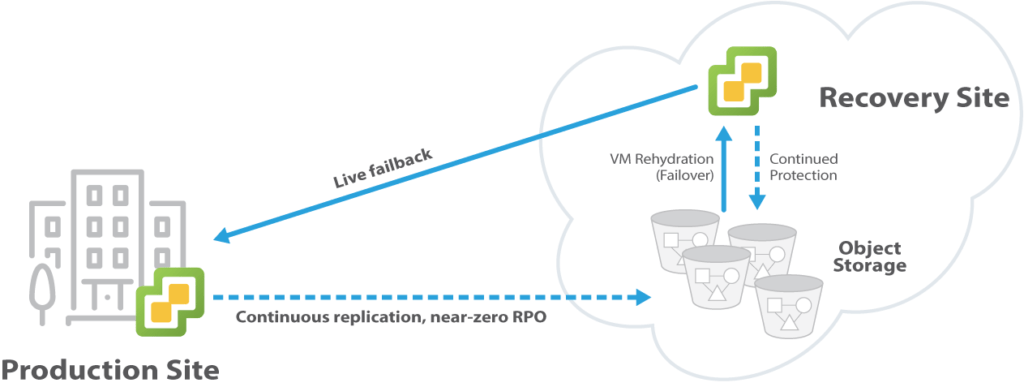Configuration Use Cases for JetStream DR for AVS
JetStream DR can be configured and deployed in several different ways, depending on the protection services required and the type of software-defined data center being protected:
On-Premises Data Center to Cloud Object Store & Cloud Data Center (DRaaS)
VMs running in an organization’s VMware-based data center are continuously replicated to an S3-compatible object store or Azure Blob Storage (ABS). In the event of an incident at the on-premises data center, VMs and their data can be rehydrated and resume operation in a VMware-based recovery environment. While the VMs are running in the recovery environment, they continue to replicate data to the object store. After the on-premises data center is restored, the VMs and their data (including any new data generated by the VMs in the cloud data center) can return to their original data center without interruption (“live fail back”).

Recovery Site Located Independently of Object Store
In this configuration, the service provider employs an object store in one data center but provides for the VMs and their data to be recovered in a different data center. The object store and/or the recovery site may be provided by a third party or cloud service provider.

Simple Replication to Object Storage
In this use case, the object store is used to protect data for the protected VMs, but no recovery site is provisioned. This presumes that the protected environment is can be restored, or alternative runtime environments are available. This use case may be relied on to economically maintain copies of the organization’s data in a remote location, as is recommended in the “3-2-1” data protection model.

Cloud-Internal DR
In this configuration, the cloud services provider hosts its customer’s primary environment in one data center and protects its VMs and their data by continuously replicating to an object store or Blob Storage in another one of its cloud data centers. In the event of an incident, VMs and data are recovered from the object store located in the second data center and can be recovered to either data center via rehydration (DR). This protection can be bi-directional, with data center “A” protecting data center “B”, and vice-versa.

